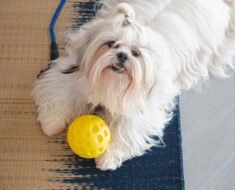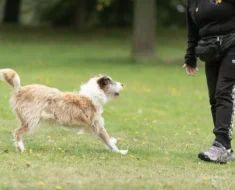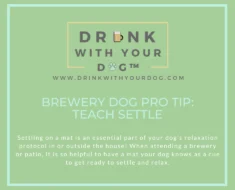1) What This Guide Covers (Quick Summary)
This playbook shows you how to ease your dog from WFH clinginess to confident alone-time. You’ll get a timeline, training steps, a home setup that favors calm, and tools that reduce stress. Everything is designed for busy workdays—short, consistent reps that add up. Where gear helps, you’ll see product-anchor links to Amazon search pages (e.g., dog crate, puzzle feeder) so you can compare brands without guesswork.
2) What Is Separation Anxiety? (Fast Definition)
Separation anxiety is an intense, panic-like response when a bonded person leaves. Dogs may vocalize, destroy exit points, pace, drool, or refuse food. It isn’t “naughtiness”; it’s distress. The solution is behavioral therapy (desensitization + counterconditioning), sensible routines, and sometimes vet-guided aids like a calming wrap/shirt or pheromone diffuser.
2.1 Separation Anxiety vs. Boredom vs. Under-Exercise
- Boredom: Calm but destructive chewing, normal appetite, naps when you’re out.
- Under-exercise: Restless energy, exuberant greetings, improves after workouts using a slow feeder or sniff games.
- Separation anxiety: Panic signs near exits, can’t settle, ignores treat-dispensing toys, heavy panting or salivation.
2.2 Common Signs & Early Red Flags
Shadowing, whining when doors close, hyper-greetings, door scratching, indoor accidents (house-trained dogs), or frantic barking soon after you leave—use a pet camera to confirm.
3) Readiness Check: Is Your Dog at Risk?
3.1 Risk Factors (History, Breed, Age, Routine Changes)
Rehomed dogs, pandemic puppies, highly social breeds, single-pet homes, sudden schedule shifts, or recent household changes can raise risk. If you already rely on a snuffle mat or lick mat for calm, you’re ahead.
3.2 Baseline Behavior Log (Free Template)
Create a tracker (Date, Alone-Time Length, Pre-Leave Calm 0–3, During, After, Notes). Consider filming via treat-tossing camera to measure “time-to-settle.”
4) Your Return-to-Office Timeline
4.1 Two Weeks Before: Foundations & Environment Setup
- Calm Independence: Reinforce settle on a mat while you move around; serve breakfast in a puzzle feeder.
- Micro-Separations: Shut a door for 5–30 seconds; return calmly.
- Space Choice: Pick crate, playpen, or dog-safe room—browse dog crate, indoor dog playpen, dog gate.
- Sound/Scents: Add a white noise machine and pheromone diffuser.
- Enrichment: Rotate lick mats, snuffle mats, and treat-dispensing toys.
4.2 One Week Before: Graduated Alone-Time Sessions
Start with departures your dog can handle without distress (even 15–30 seconds), then build. Use a smart plug to automate white noise and lights for realism.
4.3 Day Before & Day Of: Dress Rehearsal + First Real Day
Run the full morning routine; leave at your current easy duration. Monitor via pet camera; keep greetings neutral.
4.4 First Week Back: Tuning Schedule & Supports
Keep timing predictable, and book interim help: a dog walker setup (hands-free leash) or a day or two of daycare supplies.
5) Core Training: Desensitization & Counterconditioning
5.1 How to Run Graduated Absences (Step-by-Step)
- Find your dog’s calm threshold.
- Start just under that number.
- Increase by 5–20% per rep if calm.
- If stress appears, drop back and rebuild. Use a treat pouch to reinforce quiet settling before you step out.
5.2 Neutralizing “Departure Cues” (Keys, Shoes, Bag)
Randomize cues: pick up keys and sit; put on shoes and watch TV; pack your work tote and stay home. Break the cue → panic chain.
5.3 Arrival Protocol: Calm In, Calm Out
Arrive quietly. Leash off, water, a calm “hello,” then ignore for 2–3 minutes. If your dog ramps up, redirect to a snuffle mat.
6) Daily Structure That Prevents Anxiety
6.1 Morning Routine (Exercise → Settle → Brief Absence)
- 20–40 minutes brisk walking + 5 minutes of cues (sit, down, place).
- Feed via slow feeder or puzzle bowl to encourage post-meal calm.
- 1–3 micro-absences to normalize departures.
6.2 Midday Helpers (Walkers, Daycare, Neighbor Check-ins)
A reliable walker early on keeps alone-time below panic thresholds. Prep a hands-free leash for consistent outings.
6.3 Evening Decompression & Sleep Hygiene
Low-key play, sniffy strolls, dim lights, white noise via smart plug.
7) Environment Setup: Calm-First Home Design
7.1 Confinement Choices: Crate, Playpen, or Dog-Safe Room
Many dogs relax best in a playpen or gate-secured room with bed, water, and a single safe chew. If using a crate, introduce it gradually.
7.2 Sound Masking, Scents, and Visual Barriers
Mask hallway noise with a white noise machine or fan; add blackout curtains to reduce visual triggers; consider a pheromone diffuser.
7.3 Safe Chews & Enrichment Rotation
Prep a weekly rotation: puzzle feeder (Mon/Wed/Fri), lick mat (Tue/Thu), treat-dispensing toy (weekend).
8) Mental Enrichment That Works (Not Just “More Toys”)
8.1 Food Puzzles & Slow Feeders
Serve meals in puzzle feeders or slow feeders to burn mental energy and create a relaxed post-meal window for departures.
8.2 Scentwork Basics (DIY Nose Games)
Scatter feed in one room; progress to box searches. Keep a dedicated snuffle mat for “calm down” drills.
8.3 Lick Mats, Long-Lasting Chews, and Safe Stuffables
Batch-prep freezer lick mats and soft stuffable toys on Sunday for the workweek.
9) Tech Helpers: Monitoring & Remote Reinforcement
9.1 Pet Cameras: What to Watch For
Track time to settle, barking frequency, and rest cycles. Start with a simple pet camera; upgrade later if needed.
9.2 Treat-Tossing Devices & Two-Way Audio
Use a treat-tossing camera to reward quiet or interrupt early fussing—sparingly, to avoid dependency.
9.3 Smart Plugs, Timers, and Schedules
Automate white noise and soft lamps via smart plugs so your environment is consistent.
10) Crate Training & Alternatives (Humane, Step-by-Step)
- Feed meals in the crate or playpen with the door open.
- Add a chew inside; close door for 10–60 seconds while you remain nearby.
- Build to short out-of-sight moments, then to brief exits.
- If stress appears, step back; consider a dog gate room setup temporarily.
11) Exercise & Stress Biology (Why Timing Matters)
A balanced mix of physical + mental work creates a settle window 20–40 minutes later—perfect for departures. Keep arousal in check; pair exercise with a puzzle bowl or calm sniff walk.
12) Supplements & Calming Aids (Vet-Guided Only)
Start with behavior first. If needed, discuss calming wraps/shirts, pheromone diffusers, and dog calming music with your vet. Moderate-to-severe cases may benefit from medication alongside training.
13) Troubleshooting: If Your Dog Panics or Backslides
- Lower criteria to the last easy success.
- Shorten pre-departure rituals; use white noise during known triggers (delivery windows).
- Add midday support (walker/daycare) temporarily and re-build.
14) Special Cases
- Pandemic puppies: Go extra slow; keep enrichment varied (rotate snuffle mats/lick mats).
- Rescues: Ultra-predictable routines; simple playpen setup early on.
- Multi-dog homes: Train individually; don’t rely on a second dog to “fix” anxiety.
- Seniors/medical: Rule out pain; add ramps, orthopedics; keep puzzle feeders low-effort.
15) Medical Rule-Outs (Don’t Miss These)
Check for GI upset, urinary infections, thyroid issues, pain, or cognitive decline. If accidents are new, call your vet before assuming behavioral roots. A calm-supportive setup (e.g., pheromone diffuser + white noise) buys time while you investigate.
16) When to Hire a Pro (Trainer/Behaviorist)
Look for KPA-CTP, CSAT, IAABC, or CCPDT certifications. Remote coaching works well; your pro may recommend specific enrichment (e.g., treat-dispensing toys) tailored to your dog.
17) Your 14-Day Back-to-Office Plan (Template)
Week 1 (Micro-Absences & Calm Departures)
- Mon–Tue: 10–60 sec exits × 6–10 reps; keep a treat pouch handy to reward quiet.
- Wed–Thu: 1–3 min exits × 6–8 reps; ambient white noise on.
- Fri: 3–5 min; single puzzle feeder only (avoid over-exciting toys).
- Sat–Sun: One longer rehearsal (5–10 min) + easy wins.
Week 2 (Stretch Durations & Realistic Rehearsals)
- Mon–Tue: 10–15 min once/day; short easy reps otherwise.
- Wed: 20–30 min; test a pet camera notification setting.
- Thu: 30–40 min; use smart plug to pre-start noise/light.
- Fri: 45–60 min; line up a hands-free leash walk before departure.
- Weekend: Repeat last calm duration; plan first full office day at that level.
If distress appears, drop to the last easy level for 1–2 days, then progress in smaller steps.
18) Printable Daily Schedule & Tracker
- Morning: brisk walk → settle → 1–2 micro-absences → set up lick mat or puzzle feeder.
- Midday: walker/daycare/neighbor check-in (if needed).
- Evening: sniffy stroll, decompression, lights-out routine; white noise on.
19) FAQs (Snippet-Ready)
How long can most dogs be left alone?
Well-trained adults often manage 4–6 hours, built gradually; use pet cameras to confirm.
Is daycare or a walker better?
Depends on your dog: social butterflies thrive with daycare; homebodies relax with a walker (consider a hands-free leash for smoother pickups).
Do calming chews really work?
Some help mild cases; talk to your vet. Try environmental supports like a pheromone diffuser and white noise first.
What if neighbors complain about barking?
Share your plan, add white noise, and shorten training steps. A treat-tossing camera can reward quiet intervals.
20) Myths vs. Facts
- Myth: “Ignore the dog and it goes away.”
Fact: Structured graduated practice is kinder and more effective (use puzzle feeders to create calm states). - Myth: “More exercise solves everything.”
Fact: Over-exercise can raise arousal; balance with sniff work and a slow feeder. - Myth: “Crates cause anxiety.”
Fact: Poor introductions cause stress; well-taught crates and playpens can signal rest.
21) Affiliate Shopping Hub: Product Search Links (Amazon)
Each link uses product anchor text and opens the Amazon search page so you can compare brands/sizes. (Your tag is embedded; readers see only clean anchor text.)
- Dog crate
- Indoor dog playpen
- Dog gate
- White noise machine
- Dog pheromone diffuser
- Dog puzzle feeder
- Dog lick mat
- Snuffle mat for dogs
- Dog treat-dispensing toy
- Pet camera
- Treat-tossing pet camera
- Smart plug
- Calming wrap/shirt
- Dog calming music
22) References & Evidence Notes
Separation distress responds best to gradual desensitization, counterconditioning, predictable routines, and supportive environments. Tech aids and enrichment support behavior change; they don’t replace it. Consult your veterinarian for persistent distress or when medical contributors are suspected.
23) Conclusion & Next Steps
Returning to the office doesn’t have to break your dog’s heart—or your furniture. Start two weeks out with independence games and environment tweaks. Layer in graduated absences, keep departures boring, and track progress with your camera and log. Use midday help in the first month to protect gains.
When you’re ready to gear up, the inline product links (e.g., dog crate, white noise machine, puzzle feeder) and the Shopping Hub above make it simple to compare options and choose what fits your dog and routine.





